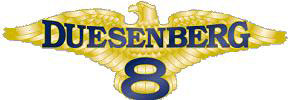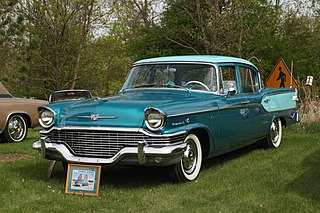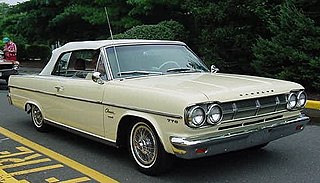A classic car is typically an automobile 25 years or older; however, definitions vary. A common theme is that of an older car of historical interest is collectible and tends to be restored rather than scrapped, though sometimes age is not a factor. Classic cars are often considered a subset of a broader category of "collector cars," including restored classic cars and newer exotic vehicles. A subset of classic cars are known as antique cars, manufactured before 1980, or vintage cars, manufactured before World War II.

The Jaguar E-Type, or the Jaguar XK-E for the North American market, is a British front mid-engined sports car that was manufactured by Jaguar Cars Ltd from 1961 to 1974. Its combination of exceptional aesthetics, advanced technologies, high performance, and competitive pricing established the model as an icon of the motoring world. The E-Type's claimed 150 miles per hour (240 km/h) top speed, sub-7-second 0 to 60 mph (97 km/h) acceleration, largely unitary body construction, front and rear independent suspension with disc brakes, mounted inboard at the rear, and rack-and-pinion steering, distinguished the car and spurred industry-wide changes.

LaSalle was an American brand of luxury automobiles manufactured and marketed, as a separate brand, by General Motors' Cadillac division from 1927 through 1940. Alfred P. Sloan, GM's Chairman of the Board, developed the concept for four new GM marques - LaSalle, Marquette, Viking and Pontiac - paired with already established brands to fill price gaps he perceived in the General Motors product portfolio. Sloan created LaSalle as a companion marque for Cadillac. LaSalle automobiles were manufactured by Cadillac, but were priced lower than Cadillac-branded automobiles, were shorter, and were marketed as the second-most prestigious marque in the General Motors portfolio. LaSalles were titled as LaSalles, and not as Cadillacs. Like Cadillac — named after Antoine de la Mothe Cadillac — the LaSalle brand name was based on that of another French explorer, René-Robert Cavelier, Sieur de La Salle.

The Cadillac V-16 was Cadillac's top-of-the-line model from its January 1930 launch until 1940. The V16 powered car was a first in the United States, both extremely expensive and exclusive, with every chassis being custom-finished to order. Only 4,076 were constructed in its 11-year run, with the majority built in its debut year before the Great Depression took strong hold. The onset of World War II reduced the sales, resulting in its demise. It was, however, at least three times cheaper than Bugatti Royale.

The Chrysler flathead engine is a flathead automotive engine manufactured by the Chrysler Corporation from 1924 through the early 1960s. The flathead engine came in four-,six-, and eight-cylinder configurations and varying displacement, with both a cast iron and cast aluminum cylinder head. It was installed in Chrysler, DeSoto, Dodge and Plymouth branded vehicles.

Duesenberg Automobile & Motors Company, Inc. was an American racing and luxury automobile manufacturer founded in Indianapolis, Indiana, by brothers Fred and August Duesenberg in 1920. The company is known for popularizing the straight-eight engine and four-wheel hydraulic brakes. A Duesenberg car was the first American car to win a Grand Prix race, winning the 1921 French Grand Prix. Duesenbergs won the Indianapolis 500 in 1922, 1924, 1925 and 1927. Transportation executive Errett Lobban Cord acquired the Duesenberg corporation in 1926. The company was sold and dissolved in 1937.

The Chrysler Imperial, introduced in 1926, was Chrysler's top-of-the-line vehicle for much of its history. Models were produced with the Chrysler name until 1954, after which it became a standalone brand; and again from 1990 to 1993. The company positioned the cars as a prestige marque to rival Cadillac, Continental, Lincoln, Duesenberg, Pierce Arrow, Cord, and Packard. According to Antique Automobile, "The adjective 'imperial' according to Webster's Dictionary means sovereign, supreme, superior or of unusual size or excellence. The word imperial thus justly befits Chrysler's highest priced model."

The Peerless Motor Car Company was an American automobile manufacturer that produced the Peerless brand of motorcars in Cleveland, Ohio, from 1900 to 1931. One of the "Three Ps" – Packard, Peerless, and Pierce-Arrow – the company was known for building high-quality luxury automobiles. Peerless popularized a number of vehicle innovations that later became standard equipment, including drum brakes and the first enclosed-body production cars.

The Studebaker President was the premier automobile model manufactured by the Studebaker Corporation of South Bend, Indiana (US) from 1926 until 1942. The nameplate was reintroduced in 1955 and used until the end of the 1958 model when the name was retired.

The Chrysler Saratoga is an automobile built by Chrysler. The nameplate was used from 1939 to 1952 and from 1957 to 1960 in the U.S. market, in Canada through 1965, and in Europe from 1989 to 1995. In the beginning, it was introduced as a sport luxury model, using the Straight Eight engine from the Chrysler New Yorker which was more formal, and the Imperial which had graduated to special order limousine.

The Austin 7 is an economy car that was produced from 1923 until 1939 in the United Kingdom by Austin. It was nicknamed the "Baby Austin" and was at that time one of the most popular cars produced for the British market and sold well abroad. Its effect on the British market was similar to that of the Model T Ford in the US, replacing most other British economy cars and cyclecars of the early 1920s. It was also licensed and copied by companies all over the world. The first BMW car, the BMW Dixi, was a licensed Austin 7. In France they were made and sold as Rosengarts, and in the United States they were built by the American Austin Car Company. In Japan, Nissan also used the 7 design as the basis for their first cars, although not under licence. This eventually led to a 1952 agreement for Nissan to build and sell Austins in Japan under the Austin name.
Hansa-Automobil Gesellschaft m.b.H was a German car brand established in 1905, which in 1914 was merged with Norddeutsche Automobil und Motoren AG (NAMAG) into Hansa-Lloyd-Werke A.G.. From 1929 to 1931 it was taken over by the Borgward group. Hansa was based in the Bremen suburb of Hastedt.

The Bentley 3 Litre was a car chassis manufactured by Bentley. The company's first, it was developed from 1919 and made available to customers' coachbuilders from 1921 to 1929. The Bentley was very much larger than the 1368 cc Bugattis that dominated racing at the time, but double the size of engine and strength compensated for the extra weight. The 4000 lb (1800 kg) car won the 24 Hours of Le Mans in 1924, with drivers John Duff and Frank Clement, and again in 1927, this time in Super Sports form, with drivers S. C. H. "Sammy" Davis and Dudley Benjafield. Its weight, size, and speed prompted Ettore Bugatti to call it "the fastest lorry in the world", which was regarded as a compliment. Built in 3 main variants, Blue label, Red Label Speed models all carrying a 5-year warranty, and the coveted and rare Green Label 100 mph cars, which only carried a 12-month warranty reflecting the high state of tune.

The Nash Ambassador is a luxury automobile produced by Nash Motors from 1927 until 1957. It was a top trim level for the first five years, then from 1932 on a standalone model. Ambassadors were lavishly equipped and beautifully constructed, earning them the nickname "the Kenosha Duesenberg".

The Rambler Classic is an intermediate-sized automobile built and marketed by American Motors Corporation (AMC) from the 1961 through 1966 model years. The Classic replaced the Rambler Six and Rambler Rebel V8 names, which were retired at the end of the 1960 model year.

Graham-Paige was an American automobile manufacturer founded by brothers Joseph B. Graham (1882–1970), Robert C. Graham (1885–1967), and Ray A. Graham (1887–1932) in 1927. Automobile production ceased in 1940, and its automotive assets were acquired by Kaiser-Frazer in 1947. As a corporate entity, the Graham-Paige name continued until 1962.

The Bucciali was a French automobile manufactured from 1922 until 1933.

The Western Antique Aeroplane and Automobile Museum (WAAAM) is located in Hood River, Oregon, United States, adjacent to the Ken Jernstedt Memorial Airport. WAAAM is a nonprofit 501(c)(3) organization committed to the preservation of, and education about aviation, automobile, and other historic transportation-related relics.

Model Products Corporation, usually known by its acronym, MPC, is an American brand and former manufacturing company of plastic scale model kits and pre-assembled promotional models of cars that were popular in the 1960s and 1970s. MPC's main competition was model kits made by AMT, Jo-Han, Revell, and Monogram.

The Chrysler Six was a series of cars that were all installed with the Chrysler Straight Six when the company assumed operations of the Maxwell Automobile Company in 1924, and Chalmers Automobile Company in 1926. The Chrysler Six initially consisted of several Models, then Series designations that originally declared the approximate top speed each vehicle was able to consistently maintain, then each series number was incrementally updated every new model year, and each series was offered in several body style choices. The engines were technically advanced for their time and were entered in the 24 Hours of Le Mans for 1925, 1928 and 1929.

















